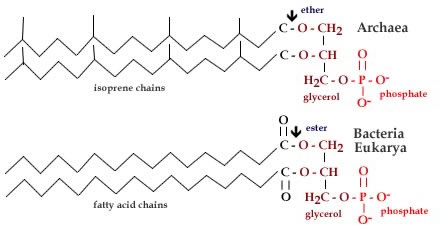| 11. Lipids and Membranes |
Tweet | |||
|
|
|
Membranes are a defining feature of all cells. The plasma membrane defines the boundary between the outside and the inside of the cell. The differences between the two are profound. Outside is mostly water, with few complex molecules. |
 |
|
|
Inside is a highly concentrated (~ 60 mg/ml) solution of proteins, nucleic acids, and smaller molecules, known collectively as cytoplasm. This bounded system (the cell) has the properties of life. It can reproduce itself by using energy imported from beyond itself. The membrane controls and mediates the interactions between the cell and the outside world. This includes what molecules can enter or leave the cell, how the cell interacts with other cells, and (indirectly) the overall shape of cells and their movements. |
|
Cells are homeostatic. Assuming that a perturbation is not too severe, the cell can recover and return to its "normal" state. Cells are also adaptive, they can change their behavior in response to signals from their environment. Most importantly, they have heredity, and so populations of cells can evolve over time. Biological membranes are composed of two general classes of molecules, proteins (which we will discuss in much greater detail in the next section of the course) and lipids. |
|
|
 |
Lipids are a structurally heterogeneous group of compounds characterized by the presence of distinct hydrophilic and hydrophobic domains. |
|
The hydrocarbon regions of fatty acids and cholesterol (and other lipids) are extremely hydrophobic and so are insoluble in water. In contrast, the carboxylic acid group is extremely hydrophilic. In aqueous solution, entropic effects will drive the assembly of lipids into micelles, bilayers, and other more complex structures. In these structures, the lipid's hydrophobic tail is sequestered away from contact with water, while at the same time, its hydrophilic head is immersed in water. |
|
|
|
Building a membrane: The plasma membrane is built on a foundation of lipids. There are many different lipids found in membranes. In fact there is a new area of study, known as lipidomics [link] that examines the diversity of lipids and their role on cell behavior and disease. It is worth noting here that, unlike proteins, nucleic acids, and carbohydrates lipids are not a structurally coherent group. Structurally different molecules, such as cholesterol and phospholipids, are both considered lipids. What they have in common is their amphipathic nature. A major class of lipids found in all types of organisms are molecules built by adding chemical groups to glycerol (which we introduced previously as a highly hydrophilic molecule). |
|
|
In the bacteria and eukarya, glycerol's two other -OH groups are coupled to unbranched fatty acid chains through condensation reactions. This forms an ester linkage between the fatty acid and the glycerol moieties. In the Archaea, branched isoprene chains (rather than fatty acids) are attached to glycerol via ether linkages. |
 |
In water, both types of lipid molecules organize themselves to minimize the exposure of their hydrophobic groups to water. This entropy-driven process leads to the formation of a bilayer membrane. |
|
|
|
Questions to answer |
|
|
Questions to ponder |
|
|
|
|
[ talk amongst yourselves about the questions]
|
| replace with revised beSocratic activity |
|
revised 10-May-2014
|